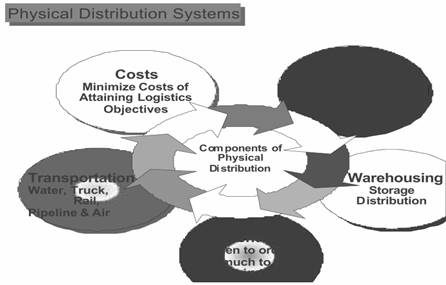Physical distribution refers to the activities—orders processing, inventory management, materials handling, warehousing, and transportation—used to move products from producers to consumers and other end users.

Order processing: The distribution process is activated by a customer order. The order cycle includes the time spent in processing the order as well as the time taken by the physical motion and therefore depends on the speed and efficiency of (hest.: operations, Electronic systems are now available to reduce the time needed for the flow of information and communications.
Order processing is the receipt and transmission of sales order information.
Efficient order processing facilitates product flow.
There are three main tasks in order processing.
- Order entry begins when customers or salespersons place orders by mail, telephone, or computer.
- Order handling involves several tasks.
- Transmission of orders to the warehouse
- Verification of product availability
- Checking of prices, terms, and customers’ credit ratings
- Instructions to the warehouse to fill the order
- Order delivery
- The warehouse schedules pickup with an appropriate carrier.
- Premium transportation is used if the customer is willing to pay for rush service.
- The customer is billed; inventory records are adjusted; and the order is delivered.
Methods of order processing
- Manual order processing suffices for a small volume of orders and is more flexible in special situations.
- Electronic data interchange (EDI) integrates order processing with production, inventory, accounting, and transportation.
- EDI is an information system for the supply chain.
- Many companies are pushing their suppliers toward EDI to reduce distribution costs and cycle times.
- The Internet is another opportunity for EDI systems.
Since the costs of physical distribution can amount to more than a quarter of sales price at manufacturing level and the necessary assets can amount to as much as a third of the corporate assets, it is important for management to keep these costs down. It is possible to keep visible costs, such as ware- housing, inventory and transport, down when the logistics functions are integrated. The invisible costs are due to customer dissatisfaction caused by late deliveries, lost sales/orders, etc. Control of these costs, both visible and hidden, is very difficult owing to the effect of any changes on customer service levels. Improvement of the latter can increase costs and a decrease in costs may mean a drop in the quality of the service. Physical distribution management provides guidelines for keeping a balance between cost and service levels
Transport is an important part of logistics since inadequate transport provision can increase inventory costs prohibitively, as well as the investment in inventory; it can also cause customer dissatisfaction and increase the invisible costs dramatically. Therefore the selection of the right mode of transport, which is efficient and dependable, is essential for the achievement of distribution objectives. The five modes are: rail, road, sea/ waterways, air and pipeline, plus combinations of some or all of these. The possibilities must be considered for cost, reliability and possibility of risk/damage.

